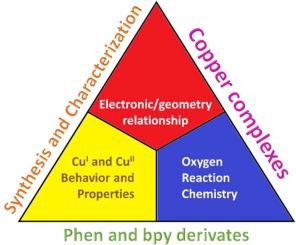Coordination Chemistry Reviews ( IF 20.3 ) Pub Date : 2022-11-28 , DOI: 10.1016/j.ccr.2022.214943 Adolfo I.B. Romo , Monilson P. dos Reis , Otaciro R. Nascimento , Paul V. Bernhardt , Joaquín Rodríguez-López , Izaura C.N. Diógenes

|
Copper complexes are highly versatile species that find promising uses in broad fields such as catalysis, drug design, and bioinorganic applications. However, copper complexes display a rich chemical behavior in solution due to their oxidation-state dependent geometrical rearrangements that make it daunting to the inexperienced. This review summarizes the advances in the synthesis of copper complexes containing phenanthroline- and bipyridine-like ligands covering from the electronic aspects of Cu(I) and Cu(II) metal ions to the intricate mechanisms of helicate formation and generation of reactive oxygen species (ROS). To illustrate the complexity of Cu complexes and strategies to address it, we will focus on three main aspects of their chemistry: 1) their electronic/geometric structure relationships, 2) the formation and behavior of helicates, and 3) oxygen reaction chemistry with copper complexes. In the first case, g values from EPR spectroscopy are discussed as a powerful method to elucidate the molecular structure of different copper complexes using crystal field approximations and the R parameter. Also, we correlate these with the geometries and the electronic properties observed for different copper species. In the second case, we cover structural changes observed in helicates from the synthesis of tetracoordinate ligands to trimetallic species. We consider relevant equilibria in the helicates, and we discuss the chiral separation of diastereosimers and their properties. In addition, we summarize oxygen reduction by copper(I) complexes and the oxygen adducts determined for hydroxyl and peroxyl radicals in different solvents. Their water oxidation chemistry and the concept of “autoreduction” that many copper complexes have is addressed. Lastly, we revised photoinduced charge transfer activates the electron transfer mechanisms proposed for copper complexes onto support TiO2 receiving charge injection from copper photosensitizers for use in solar cells. We describe the generation of reactive oxygen species and their detection by EPR. While the reader may find different challenges in their research on coordination chemistry, these three illustrations provide solid examples of how ligand field theory, crystal structure, and spin characterization are used to solve concrete problems posed by Cu chemistry. We hope this review will help jumpstart the novice chemist into the fascinating chemistry of Cu complexes and provide new discussion and conceptual tools to more advanced researchers.
中文翻译:

电子和几何结构对铜菲咯啉、联吡啶和衍生物配合物的相互作用、合成、表征和对氧的反应性
铜络合物是用途广泛的物种,在催化、药物设计和生物无机应用等广泛领域具有广阔的应用前景。然而,铜络合物由于依赖于氧化态的几何重排在溶液中表现出丰富的化学行为,这让没有经验的人望而生畏。这篇综述总结了含有菲咯啉和联吡啶类配体的铜配合物的合成进展,涵盖了从 Cu(I) 和 Cu(II) 金属离子的电子方面到螺旋形成和活性氧物种产生的复杂机制 (活性氧)。为了说明 Cu 配合物的复杂性和解决它的策略,我们将重点关注其化学的三个主要方面:1) 它们的电子/几何结构关系,2) 螺旋的形成和行为,3) 与铜络合物的氧反应化学。在第一种情况下,EPR 光谱的 g 值被讨论为使用晶场近似和 R 参数阐明不同铜络合物分子结构的有效方法。此外,我们将这些与观察到的不同铜物种的几何形状和电子特性相关联。在第二种情况下,我们涵盖了从四配位配体合成到三金属物种的螺旋体中观察到的结构变化。我们考虑了螺旋体中的相关平衡,并讨论了非对映异构体的手性分离及其性质。此外,我们总结了铜 (I) 络合物的氧还原和不同溶剂中羟基和过氧自由基的氧加合物。他们的水氧化化学和许多铜络合物具有的“自还原”概念得到解决。最后,我们修改了光诱导电荷转移激活了铜配合物到载体 TiO 上的电子转移机制2从用于太阳能电池的铜光敏剂接收电荷注入。我们描述了活性氧的产生及其通过 EPR 的检测。虽然读者在配位化学研究中可能会遇到不同的挑战,但这三个插图提供了配体场论、晶体结构和自旋表征如何用于解决铜化学所带来的具体问题的具体例子。我们希望这篇综述能够帮助新手化学家快速了解 Cu 配合物的迷人化学,并为更高级的研究人员提供新的讨论和概念工具。











































 京公网安备 11010802027423号
京公网安备 11010802027423号